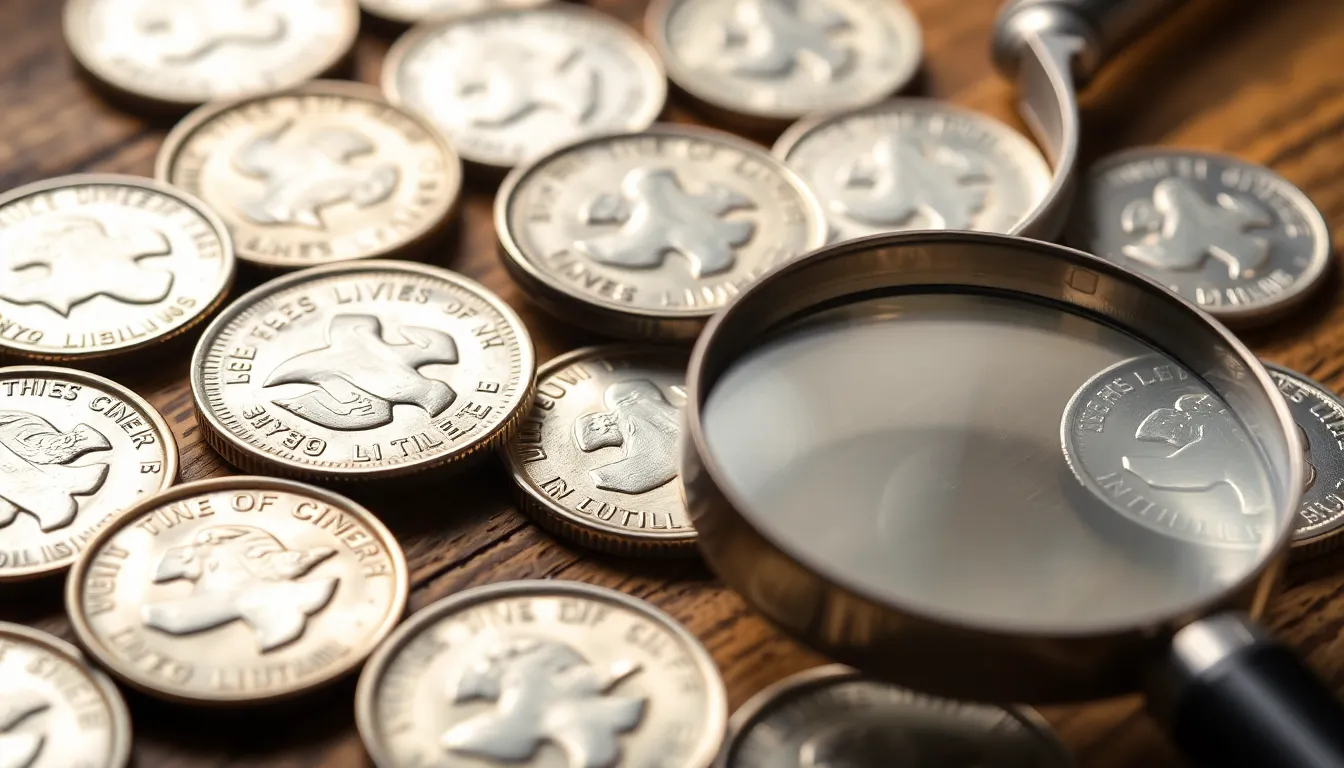In a world where a cup of coffee can cost more than a dime, it’s easy to overlook the small change rattling around in pockets and jars. But what if those modern dimes are hiding a secret? Some of them could be worth a pretty penny—literally! From rare mint errors to unique designs, these little coins pack a surprising punch in the collector’s market.
Table of Contents
ToggleUnderstanding Modern Dimes
Modern dimes feature significant variations that can enhance their value. Collectors often seek dimes with unique characteristics such as rare mint errors and special commemorative designs. A dime minted from 1975 to 1998, for instance, may sell for higher prices due to unique features or errors during production.
Dimes from specific years may draw more interest. For example, the 1982 and 1983 dimes are known for their significant error coins, which can command high premiums. A dime with an obvious rim or double die error may value hundreds of dollars.
Grading plays a crucial role in determining the monetary worth of a dime. Coins rated at higher grades, like MS-65 or above, exhibit less wear and better visual appeal. Consequently, the condition greatly influences collector interest and market price.
Market demand shifts continually. Economic trends may increase the desirability of certain dimes, particularly those linked to historical events or those from limited mintages. Auctions and local coin shows often reveal current market trends, guiding potential buyers in their search for valuable modern dimes.
Among modern dimes, certain series maintain popularity. The Roosevelt dime series, produced since 1946, encompasses various unique varieties worth investigating. Collectors often delve into this series for particular years known to have anomalies, ensuring a robust market presence.
Understanding the different factors that affect the worth of modern dimes enables collectors to make informed decisions. Keeping abreast of the evolving coin market proves essential for identifying valuable coins among everyday finds.
Factors That Influence Value

Several key factors determine the value of modern dimes in the collector market. Understanding these elements helps collectors identify potentially valuable pieces among their collections.
Mint Marks and Rarity
Mint marks provide significant insight into a coin’s rarity. Different mint locations produce varying numbers of dimes, influencing collector demand. Dimes with mint marks from the San Francisco mint often have lower production numbers, making them more desirable. Rarity increases with special releases or limited mintages, such as commemorative issues. For example, certain dimes from 1982 and 1983 feature mint errors, capturing collectors’ attention and leading to higher values. Coin collectors actively seek out these specific mint marks to enhance their collections.
Condition and Grading
Grading assesses a coin’s condition and impacts its market value. Coins graded on the Sheldon Scale, ranging from 1 to 70, reflect their visual appeal and wear. Higher-grade coins exhibit minimal scratches or discoloration, attracting interest from buyers. Collectors value well-preserved dimes, as they command significantly higher prices compared to those in lower grades. It’s common for dimes rated in the upper tiers to fetch thousands of dollars, especially when grading highlights superior quality. Collectors universally recognize the importance of condition when evaluating dimes for potential investment.
Notable Modern Dimes Worth Money
Certain modern dimes stand out in the collector’s market for their potential value. Silver content and unique minting errors contribute significantly to their worth.
Silver Dimes
Dimes minted before 1965 contain silver, making them attractive to collectors. These coins hold more value due to their metal content. Notably, the 1964 and earlier dimes have 90% silver, fetching prices well above their face value. Collectors often seek these for their bullion worth, which can exceed $2.50. As a result, finding any of these silver dimes can be financially beneficial.
Unique Errors and Variants
Several unique errors exist among modern dimes, greatly increasing their value. Noteworthy examples include the 1982 “no mint mark” dime and the 1983 “p” dime with a doubled die. These specific variants can command prices ranging from $100 to over $1,000 in high grade. Errors such as off-center strikes or incorrect dates also enhance desirability. Collectors prioritize these dimes, paying premiums for clean, well-graded examples.
How to Evaluate Your Dimes
Understanding how to evaluate dimes effectively enhances a collector’s ability to identify those worth more than face value. Several methods exist for assessing the value of modern dimes.
Professional Appraisal
Consulting a professional appraiser provides valuable insights into a coin’s worth. Experts examine factors like mint marks and grading to determine value accurately. Engaging a reputable coin dealer or numismatic expert often yields detailed evaluations. They offer significant knowledge of market trends and can identify rare varieties that a casual collector might overlook. Finding a qualified appraiser through associations such as the American Numismatic Association ensures a reliable assessment of your dimes.
Online Resources and Tools
Numerous online resources assist collectors in evaluating the value of their dimes. Websites such as PCGS and NGC provide access to comprehensive price guides and grading information. Utilizing these tools, collectors can compare their coins against established standards. Forums and social media groups also offer community insights where enthusiasts share their experiences. Engaging with these platforms helps collectors understand the market better and make informed decisions about their coins. Always verify multiple sources to ensure accurate valuations.
Tips for Collecting Modern Dimes
When collecting modern dimes, attention to detail is key. Focus on examining mint marks to uncover rarity. Dimes from the San Francisco mint often hold more value due to limited production numbers. Check for unique features, such as minting errors, which can enhance a dime’s worth significantly. The 1982 “no mint mark” and the 1983 “P” dime with a doubled die are prime examples of valuable finds.
Grading plays a major role in determining a coin’s market price. Higher-grade dimes, which show less wear, attract more collector interest. Use grading resources, like PCGS and NGC, to enhance understanding of this essential aspect. Always compare individual coins to known standards to assess their condition properly.
Building relationships with reputable coin dealers can also provide valuable insights. Experts often offer appraisal services that reveal accurate market values. Engaging with knowledgeable professionals helps illuminate characteristics that may not be immediately obvious.
Utilizing online resources and community forums aids in informed decision-making as well. Joining collectors’ groups provides opportunities for sharing knowledge and experiences. Reading price guides online can also keep collectors updated on current market trends.
Prioritize thorough research and consistent evaluation while building a collection. Collectors should remain patient, given that valuable dimes can turn up in unexpected places. Forming connections with fellow enthusiasts allows for a greater exchange of tips and information, leading to more successful collecting endeavors.
Modern dimes can surprise collectors with their hidden value. By focusing on rare mint errors and unique designs collectors can uncover coins worth much more than their face value. Understanding mint marks and grading is crucial for determining a dime’s worth.
Engaging with reputable dealers and utilizing online resources can enhance a collector’s knowledge and help identify valuable coins. With patience and attention to detail collectors can turn everyday finds into impressive additions to their collections. The world of modern dimes offers exciting opportunities for those willing to explore its depths.


